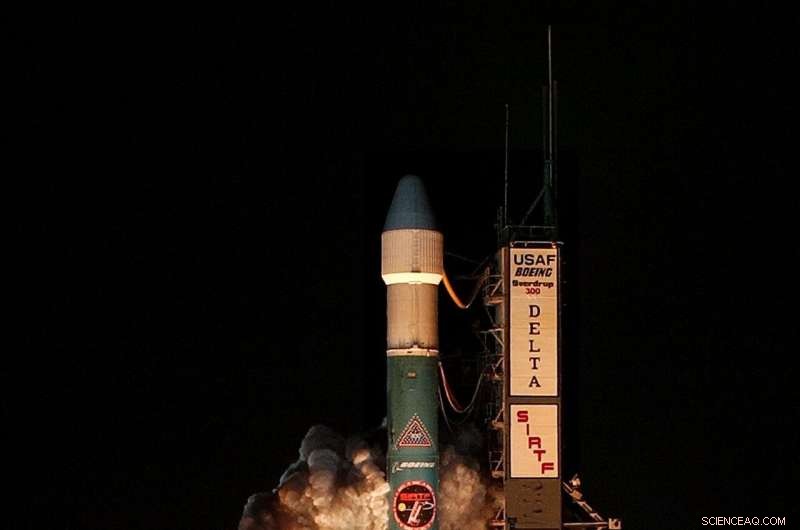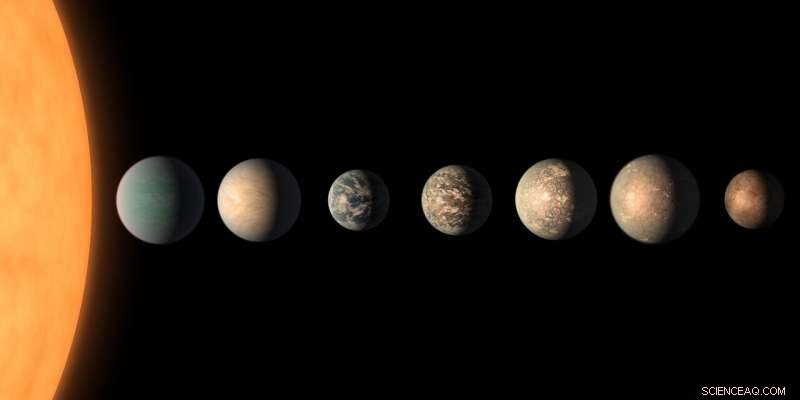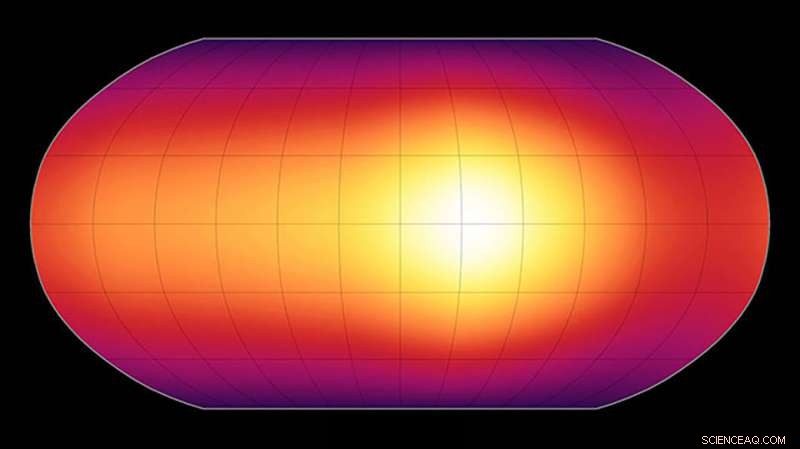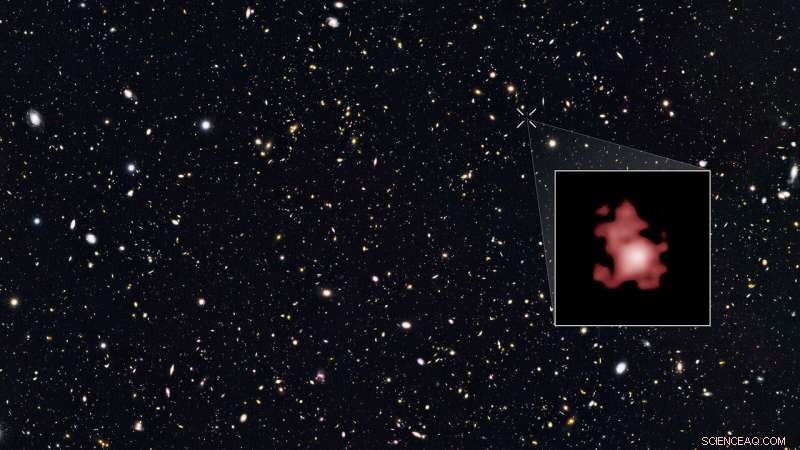
Le télescope spatial Spitzer de la NASA, alors connu sous le nom de Space Infrared Telescope Facility, est lancé depuis la base aérienne de Cape Canaveral en Floride lundi, 25 août, 2003. Crédit :NASA
Alors qu'une fenêtre sur l'univers se ferme, un autre s'ouvrira avec une vue encore meilleure. Certaines des mêmes planètes, les étoiles et les galaxies que nous avons vues pour la première fois à travers la première fenêtre apparaîtront avec des détails encore plus nets dans celle qui s'ouvrira bientôt.
Le télescope spatial Spitzer de la NASA termine sa mission le 30 janvier 2020, après plus de 16 années extraordinaires d'exploration. Le télescope a fait de nombreuses découvertes au-delà de l'imagination de ses concepteurs, comme les planètes en dehors de notre système solaire, appelées exoplanètes, et les galaxies qui se sont formées près du début de l'univers. De nombreuses percées de Spitzer seront étudiées plus précisément avec le futur télescope spatial James Webb, dont le lancement est prévu en 2021.
"Nous avons beaucoup de nouvelles questions à poser sur l'univers à cause de Spitzer, " a déclaré Michael Werner, Scientifique du projet Spitzer basé au Jet Propulsion Laboratory de la NASA à Pasadena, Californie. "C'est très gratifiant de savoir qu'il existe un ensemble de capacités aussi puissant pour assurer le suivi de ce que nous avons pu commencer avec Spitzer."
Webb et Spitzer sont tous deux spécialisés dans la lumière infrarouge, qui est invisible aux yeux humains. Mais avec son miroir géant en béryllium doré et neuf nouvelles technologies, Webb a environ 1, 000 fois plus puissant. Le prochain télescope sera en mesure de pousser les découvertes scientifiques de Spitzer vers de nouvelles frontières, de l'identification de produits chimiques dans les atmosphères des exoplanètes à la localisation de certaines des premières galaxies à se former après le Big Bang.
Au-delà de ses découvertes, Spitzer est également un pionnier pour Webb en termes de fonctionnement d'un télescope de ce type. Afin de mesurer la lumière infrarouge avec une sensibilité élevée, un télescope doit être très froid. Spitzer a montré aux ingénieurs comment un observatoire infrarouge se comporte dans l'immensité de l'espace et à quelles températures les planificateurs de mission doivent s'attendre pour Webb.
"Avoir un énorme télescope dans l'espace est difficile. Mais avoir un énorme télescope froid est beaucoup plus difficile, " a déclaré Ambre Straughn, scientifique adjoint du projet pour James Webb Space Telescope Science Communications. "Spitzer nous a aidés à apprendre à mieux utiliser un télescope très froid dans l'espace."
Avec plus de 8, 700 articles scientifiques publiés sur la base des découvertes de Spitzer, le télescope a été un atout considérable pour les astronomes de diverses disciplines. Beaucoup de ces résultats alléchants sont mûrs pour être revisités avec un télescope plus puissant, et Webb est sur le point de commencer à les examiner au début de sa mission. Voici un échantillon des réalisations de Spitzer sur lesquelles Webb s'appuiera.

Le concept de cet artiste montre à quoi peut ressembler le système planétaire TRAPPIST-1, sur la base des données disponibles sur les diamètres des planètes, masses et distances de l'étoile hôte. Le télescope spatial Spitzer a confirmé la présence de deux planètes de la taille de la Terre dans le système avant d'en découvrir cinq autres. Crédit :NASA/JPL-Caltech
Exoplanètes
L'une des découvertes les plus étonnantes de Spitzer est qu'il n'y en a pas que trois, mais sept planètes rocheuses de la taille de la Terre en orbite autour d'un petit, étoile faible appelée TRAPPIST-1. TRAPPIST-1 est l'un des systèmes planétaires les mieux étudiés en dehors du nôtre, mais il y a beaucoup plus à apprendre à ce sujet.
La quatrième planète de l'étoile, TRAPPIST-1e est particulièrement intéressant car il a une densité et une gravité de surface très similaires à celles de la Terre et reçoit suffisamment de rayonnement stellaire pour avoir des températures suffisamment favorables à l'eau liquide. Webb observera cette planète pour avoir une meilleure idée de si la planète a une atmosphère et, si c'est le cas, quelle est sa chimie.
La présence de molécules telles que le dioxyde de carbone, dominant sur Mars et Vénus, aurait des implications pour savoir si une planète pourrait avoir de l'eau liquide et d'autres conditions habitables. Webb sera capable de détecter l'eau atmosphérique, trop. En outre, Webb recherchera la chaleur provenant de TRAPPIST-1b, la planète la plus proche de son étoile.
"La diversité des atmosphères autour des mondes terrestres dépasse probablement nos imaginations les plus folles, " a déclaré Nikole Lewis, professeur assistant d'astronomie à l'Université Cornell d'Ithaque, New York. "Obtenir des informations sur l'air sur ces planètes va être très utile."
WASP-18b est une autre planète intrigante que Spitzer a examinée et que Webb étudiera plus avant dans les observations au début de la mission. Cette géante gazeuse, avec 10 fois la masse de Jupiter, est situé tout près de son étoile, terminer une orbite une fois toutes les 23 heures. Because of its high temperature—a whopping 4, 800 degrees Fahrenheit (2, 650 degrees Celsius)—and large size, it is known as a "hot Jupiter." Using data from Spitzer and Hubble, astronomers figured out in 2017 that this planet has a lot of carbon monoxide in its upper atmosphere and little water vapor. This planet is particularly interesting because it's so close to its star that it's in danger of being torn apart completely, and it may not survive another million years. Astronomers are interested in using Webb to look at the processes happening in this planet's atmosphere, which will provide insights into hot Jupiters in general.
Spitzer has also delivered unprecedented weather reports for exoplanets. En 2007, it made the first-ever map of the surface of an exoplanet, the hot Jupiter HD 189733b, showing its temperature variations and cloud tops. Plus récemment, en 2016, Spitzer highlighted the climate patterns of 55 Cancri e, a possibly lava-covered world more than twice the size of Earth. But maps from Spitzer have given scientists a lot to think about as they look to further investigations with Webb.

This is the first-ever map of the surface of an exoplanet, or a planet beyond our solar system. The map, which shows temperature variations across the cloudy tops of a gas giant called HD 189733b, is made from infrared data taken by NASA's Spitzer Space Telescope. Credit:NASA/JPL-Caltech/Harvard-Smithsonian CfA
Other Exotic Objects
Spitzer has also made strides in identifying and characterizing brown dwarfs. A brown dwarf is larger than a planet but less massive than a star, and while stars generate their own energy by fusing hydrogen, brown dwarfs do not. Spitzer has been able to look at the clouds in brown dwarf atmospheres and observe how they move and change shape with time. Webb will also examine brown dwarf cloud properties and delve deeper into the physics of these mysterious objects.
Infrared light has also been revolutionary for looking at disks of gas and dust orbiting stars, and both Spitzer and Webb are sensitive to the infrared glow of this material. Disks that Spitzer has studied contain the raw materials for making planets and may represent the state of our solar system before Earth and its neighbors formed. Spitzer has seen particles around young stars beginning to transform into the seeds of small planetary bodies, and that some disks have materials similar to those seen in comets in our solar system. Webb can look at the same disks and find out even more about the planetary formation process.
Oodles of Galaxies
As light travels from distant objects to Earth, its wavelength becomes longer because the universe is expanding and those objects are moving farther from us. Just like the sound of a siren seems to lower in pitch as an ambulance drives away, light from distant galaxies also lowers in frequency, a phenomenon called "redshift." That means stars that give off visible light in the early universe will appear in the infrared by the time their light reaches Earth. This makes infrared light an especially powerful tool for exploring the universe's ancient past.
Pinpointing hundreds of billions of galaxies is currently impossible, but Spitzer has made large galaxy catalogs that represent different slices of the universe, containing some of the most distant galaxies we know. The large survey areas of Spitzer and Hubble Space Telescope have allowed astronomers to efficiently look for objects that could be studied in further detail with Webb.
Par exemple, Spitzer, together with Hubble, took an image of a galaxy called GN-z11, which holds the record for most distant galaxy measured yet. It is a relic from when the universe was only 400 million years old, just 3% of its current age and less than 10% of its size today.

This is the first-ever map of the surface of an exoplanet, or a planet beyond our solar system. The map, which shows temperature variations across the cloudy tops of a gas giant called HD 189733b, is made from infrared data taken by NASA's Spitzer Space Telescope. Credit:NASA/JPL-Caltech/Harvard-Smithsonian CfA
"Spitzer surveyed thousands of galaxies, mapped the Milky Way and performed other groundbreaking feats by looking at large areas of the sky, " said Sean Carey, manager of the Spitzer Science Center at Caltech/IPAC in Pasadena, Californie. "Webb won't have this capability, but it will revisit some of the most interesting targets in the Spitzer surveys to reveal them in amazing clarity."
Quoi de plus, Webb's higher sensitivity will allow the telescope to look for galaxies dating back even earlier in the universe. And questions still abound about these distant galaxies:Are there a lot of stars forming in them or relatively few? Are they rich in gas or poor? Are there black holes at their centers, and how do those black holes interact with stars? Et, scientists have pondered a chicken-and-egg problem for decades about which came first:the black hole or the surrounding galaxy?
"We'll be able to see some of the earliest galaxies to form in the universe that we've never seen before, " said Straughn.
Closer to home, Spitzer also studied many examples of a mysterious kind of galaxy called a luminous infrared galaxy, or LIRG. Such galaxies are generating tens to hundreds of times more energy per second than a typical galaxy, and most of that energy takes the form of far-infrared light. Scientists have used Spitzer to study LIRGs and learn about star formation and the growth of black holes during periods of rapid evolution when galaxies collide and merge. Such collisions were even more common 6 billion to 10 billion years ago and influenced the evolution of the universe as we know it.
"Webb will take inspiration from Spitzer and examine a variety of nearby and distant LIRGs to learn more about the role of galactic mergers, bursts of star formation and the growth of supermassive black holes in galactic evolution over cosmic time, " said Lee Armus of Caltech, who will lead a LIRG observing program for Webb.
Into the Infrared Unknown
For more than 16 years, Spitzer mapped out many of the most pressing questions in infrared astronomy. Now it's up to Webb to revisit them with sharper vision, through the grandest window yet to the cosmos.